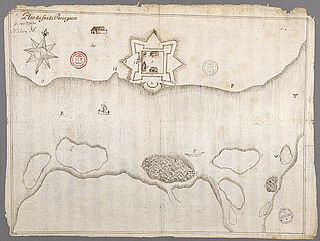
Castine is a town in Hancock County in eastern Maine, USA, which served from 1670 to 1674 as the capital of Acadia. The population was 1,366 at the 2010 census. Castine is the home of Maine Maritime Academy, a four-year institution that graduates officers and engineers for the United States Merchant Marine and marine related industries. Approximately 1000 students are enrolled. During the French colonial period, Castine was the southern tip of Acadia and briefly served as the regional capital.

Penobscot Indian Island Reservation is an Indian reservation for the Penobscot Tribe of Maine, a federally recognized tribe of the Penobscot in Penobscot County, Maine, United States, near Old Town. The population was 610 at the 2010 census. The reservation extends for many miles alongside 15 towns and two unorganized territories in a thin string along the Penobscot River, from its base at Indian Island, near Old Town and Milford, northward to the vicinity of East Millinocket, almost entirely in Penobscot County. A small, uninhabited part of the reservation is in South Aroostook, Aroostook County, by which it passes along its way northward.

The Penobscot River is a 109-mile-long (175 km) river in the U.S. state of Maine. Including the river's West Branch and South Branch increases the Penobscot's length to 264 miles (425 km), making it the second-longest river system in Maine and the longest entirely in the state. Its drainage basin contains 8,610 square miles (22,300 km2).

Fort Knox, now Fort Knox State Park or Fort Knox State Historic Site, is located on the western bank of the Penobscot River in the town of Prospect, Maine, about 5 miles (8.0 km) from the mouth of the river. Built between 1844 and 1869, it was the first fort in Maine built entirely of granite; most previous forts used wood, earth, and stone. It is named after Major General Henry Knox, the first U.S. Secretary of War and Commander of Artillery during the American Revolutionary War, who at the end of his life lived not far away in Thomaston. As a virtually intact example of a mid-19th century granite coastal fortification, it was added to the National Register of Historic Places in 1969 and declared a National Historic Landmark on December 30, 1970. Fort Knox also serves as the entry site for the observation tower of the Penobscot Narrows Bridge that opened to the public in 2007.

Peleg Wadsworth was an American officer during the American Revolutionary War and a Congressman from Massachusetts representing the District of Maine. He was also grandfather of noted American poet Henry Wadsworth Longfellow.

The Penobscot Building is the original 13-story building of the Penobscot Block complex in downtown Detroit, Michigan. It is the first Penobscot Building, and one of three buildings of the same name in the later-constructed complex. It is located at 131 West Fort Street, within the Detroit Financial District.

The Bagaduce River is a tidal river in the Hancock County, Maine that empties into Penobscot Bay near the town of Castine. From the confluence of Black Brook and the outflow of Walker Pond, the river runs about 14 miles (23 km) north, northwest, and southwest, forming the border between Brooksville on its left bank and Sedgwick, Penobscot, and Castine on its right.

The Detroit Financial District is a United States historic district in downtown Detroit, Michigan. The district was listed on the U.S. National Register of Historic Places on December 14, 2009, and was announced as the featured listing in the National Park Service's weekly list of December 24, 2009.

Fort George was a palisaded earthwork fort built in 1779 by Great Britain during the American Revolutionary War in Castine, Maine. Located at a high point on the Bagaduce Peninsula, the fort was built as part of an initiative by the British to establish a new colony called New Ireland. It was the principal site of the British defense during the Massachusetts-organized Penobscot Expedition, a disastrous attempt in July and August of 1779 to retake Castine in response to the British move. The British re-occupied Castine in the War of 1812 from September 1814 to April 1815, rebuilding Fort George and establishing smaller forts around it, again creating the New Ireland colony. The remains of the fort, now little more than its earthworks, are part of a state-owned and town-maintained park.

Nautilus Island is a privately owned island in Penobscot Bay, Maine. It is part of the Town of Brooksville, in Hancock County.

Castine is a census-designated place (CDP) in the town of Castine in Hancock County, Maine, United States. The CDP population was 1,029 at the 2010 census, out of 1,366 people in the town as a whole.

New Ireland was a Crown colony of the United Kingdom established in modern-day Maine after British forces captured the area during the American Revolution and again during the War of 1812. The colony lasted four years during the Revolution, and eight months during the War of 1812. At the end of each war the United Kingdom ceded the land back to the United States under the Treaty of Paris and Treaty of Ghent, respectively.

The Castine Historic District encompasses the entire southern tip of the peninsula on which the town of Castine, Maine is located. Covering about 1,800 acres (730 ha), this area was a center of colonial conflicts dating to the early 17th century, and was the site of military action during the American Revolutionary War and the War of 1812. Bypassed by the railroads, it has retained a village feel reminiscent of the early 19th century. It was listed on the National Register of Historic Places in 1973.

















